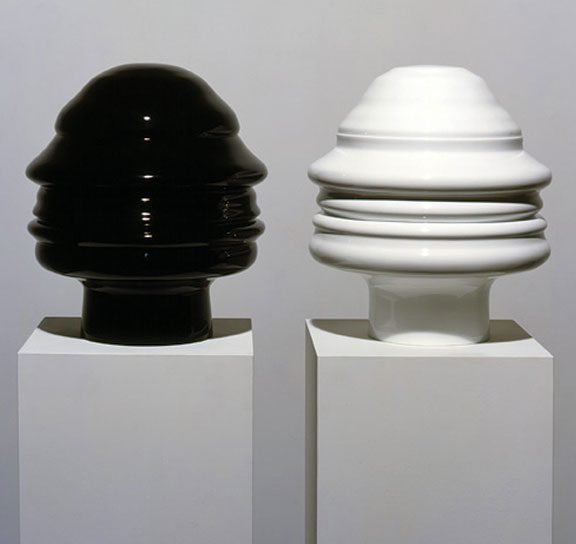





Tim Noble
Born Stroud 1966
1992–94 Royal College of Art; MA (Sculpture)
1989–92 Dean Clough, Halifax, West Yorkshire; Residency
1986–89 Nottingham Trent University; BA (Hons) Degree in Fine Art
1985–86 Cheltenham Art College; Foundation course
Sue Webster
Born Leicester 1967
1989–92 Dean Clough, Halifax, West Yorkshire; Residency
1986–89 Nottingham Trent University; BA (Hons) Degree in Fine Art
1985–86 Leicester Polytechnic; Foundation course




Tim Noble and Sue Webster take ordinary things including rubbish, to make assemblages and then point light to create projected shadows which show a great likeness to something identifiable including self-portraits. The art of projection is emblematic of transformative art. The process of transformation, from discarded waste, scrap metal or even taxidermy creatures to a recognizable image, echoes the idea of 'perceptual psychology' a form of evaluation used for psychological patients. Noble and Webster are familiar with this process and how people evaluate abstract forms. Throughout their careers they have played with the idea of how humans perceive abstract images and define them with meaning. The result is surprising and powerful as it redefines how abstract forms can transform into figurative ones.
Parallel to their shadow investigations, Noble and Webster have created a series of light sculptures that reference iconic pop culture symbols represented in the form of shop-front-type signage and carnival shows inherent of British seaside towns, Las Vegas and Times Square. With the aid of complex light sequencing these signs perpetually flash and spiral out messages of everlasting love, and hate.
Noble & Webster have created a remarkable group of anti-monuments in their 24-year career, mixing the strategies of modern sculpture and the attitude of punk to make art from anti-art. Their work derives much of its power from its fusion of opposites, form and anti-form, high culture and anti-culture, male and female, craft and rubbish, sex and violence.
In 2009, Noble & Webster were awarded Honorary Degrees of Doctor of Art at Nottingham Trent University in recognition of their contribution to contemporary British Art and their radical influence on younger generations of artists. In 2007, they were awarded the ARKEN Prize at Arken, Museum of Modern Art, Copenhagen for outstanding contribution to the international scene of contemporary art, in the same year their critically acclaimed project Polymorphous Perverse at the Freud Museum was nominated for the prestigious South Bank Prize.
Toxic Schizophrenia (Hyper Version) their first permanent public sculpture was unveiled at Museum of Contemporary Art, Denver, May 2009. Previously the public art installation Electric Fountain, was exhibited at Rockefeller Plaza, New York, February 2008. In 2009 the Trustees of the National Portrait Gallery selected The Head of Isabella Blow for inclusion to its permanent collection.
Since their first solo show in London, British Rubbish in 1996, Noble & Webster have enjoyed international recognition with solo exhibitions at Rockefeller Plaza, New York, 2008, The Freud Museum, London, 2006, CAC Malaga, 2005, Museum of Fine Arts, Boston, 2004, P.S.1/MoMA, New York, 2003, Milton Keynes Gallery, UK, 2002, Deste Foundation, Athens, 2000 and The Chisenhale Gallery, London, 1999. Their work was included in Statuephilia—Contemporary Sculptors at The British Museum, London in 2008–09 and in the exhibition Apocalypse—Beauty and Horror in Contemporary Art, at The Royal Academy, London, 2000.
Their work is in the permanent collections of the AISTHI Foundation, Beirut; Arken Museum of Modern Art, Copenhagen; Art Gallery of South Australia, Adelaide; Artis-François Pinault, France; Berengo Studio, Venice; The British Museum, London; Dakis Joannou Collection, Athens; Es Baluard Museum, Palma, Spain; The Goss-Michael Collection, Dallas; Honart Museum, Tehran, Iran; Lyonel-Feininger Museum, Quedlinburg, Germay; Museum of Contemporary Art, Denver; Museum of Contemporary Art, Los Angeles; National Portrait Gallery, London; Nicola Erni Collection, Zug, Switzerland; The Olbricht Collection, Berlin; Project Space 176–The Zabludowicz Collection, London; Saatchi Collection, London; Samsung Museum, Seoul, Korea; Schaufler Collection, Germany; Solomon R. Guggenheim Museum, New York; Wemhöner Collection, Germany.
Publications available:
Noble & Webster – 2000 Words, is a monograph that combines a critical, forthright essay with a survey of Tim Noble and Sue Webster's works in the Dakis Joannou Collection. Author Linda Yablonsky is a regular contributor to Artforum and the New York Times.
Sue Webster: The Folly Acres Cook Book, published by Other Criteria and introduced with an original poem by PJ Harvey, the publication combines recipes from the kitchen of the Gloucestershire smallholding shared by Tim and Sue, along with drawings, photographs, thoughts, anecdotes and personal memories. It is hand-typed on a 1940s Olympia Robust typewriter developed for use by the German militia during World War II.
Nihilistic Optimistic, a 104-page catalogue to accompany the on-going exhibition Nihilistic Optimistic at Blain|Southern, Hanover Square, London, together with a contribution from Gustav Metzger, an essay by Jon Savage and an interview with the artists and Hans Ulrich Obrist. Published by Blain|Southern, London, 2012.
Turning the Seventh Corner, published by Blain|Southern, London, 2011, with texts by David Adjaye and James Putnam. This is a documentation of the artists' exhibition and the sculpture The Gamekeeper's Gibbet at Blain|Southern, Berlin, 2011.
British Rubbish, a survey of the artists' work from 1996 to 2010 with a updated essay by Jeffrey Deitch, and new texts by Michael Bracewell and Nick Cave, published October 2011 by Rizzoli, New York.
Polymorphous Perverse, a documentation of works exhibited at the Freud Museum, London, providing a fascinating insight into Freud's theories and how they relate to art practice with critical essays from the distinguished American art historian Linda Nochlin and James Putnam, published by Other Criteria, London, 2008.

